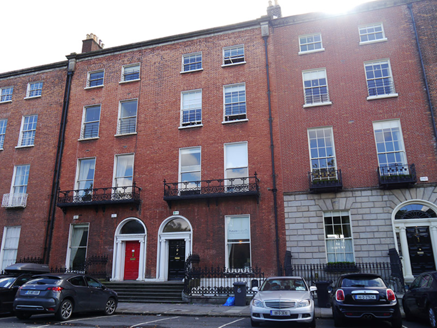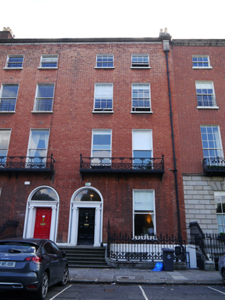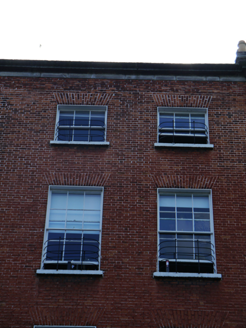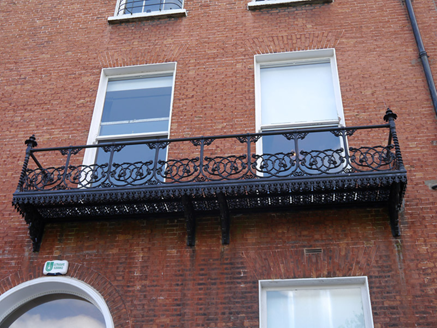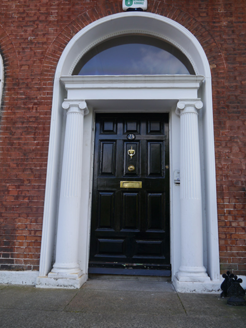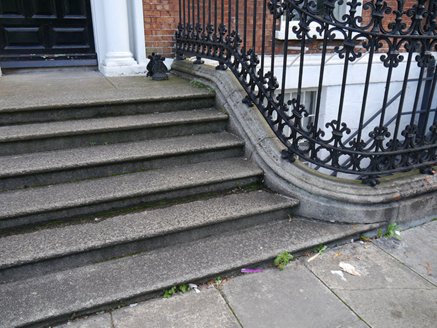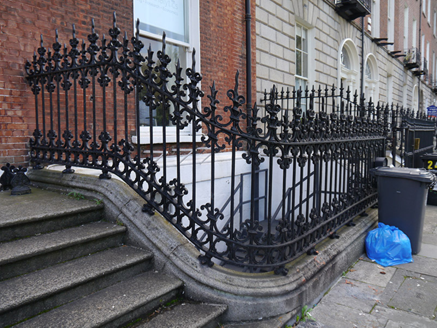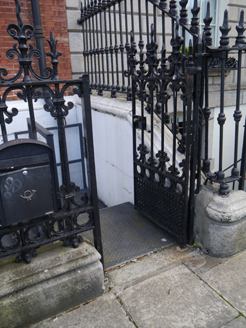Survey Data
Reg No
50930216
Rating
Regional
Categories of Special Interest
Architectural, Artistic
Original Use
House
In Use As
Office
Date
1820 - 1830
Coordinates
316485, 233005
Date Recorded
28/08/2015
Date Updated
--/--/--
Description
Terraced two-bay four-storey over basement former townhouse, built c. 1825, with shared full-height pitched return to east-bay of rear (south), abutted by two-storey return over basement with curved south corners. Now in use as offices and apartments. M-profile slate roof, hipped to east, concealed by ashlar granite parapet with moulded cornice and coping, shouldered brick chimneys to west party wall and shared to gable of full-height return, having red clay pots; parapet gutters and cast-iron downpipes to west of principal (north) elevation with hopper beneath vermiculated pier to eaves. Red brick walling in Flemish bond, English garden wall bond to rear (south), over coursed ashlar granite walling to basement, beneath granite stringcourse to north. Square-headed window openings with brick voussoirs, rendered reveals and projecting granite sills; tripartite windows to ground and first floor south; largely round-headed openings to rear returns. Iron guard rails affixed to sills of third and second floor windows of north elevation and continuous cast-iron balconette to first floor. Generally one-over-one replacement timber sliding sash windows with horns, three-over-three to third floor, six-over-six to second floor, ten-over-fifteen to basement; largely six-over-six to rear. Round-headed door opening to principal elevation (north) with moulded rendered reveals and Greek Ionic doorcase having plain frieze and cornice supported on fluted Ionic columns, with plain fanlight and eleven-panelled timber door. Granite entrance platform with cast-iron boot scraper, approached by six granite steps and flanked by decorative cast-iron railings to west over curved granite plinth, enclosing basement area. Coal-hole cover to pavement. Steel steps to basement well. Modernised two-storey mews building to rear, ashlar limestone elliptical-headed carriage-arch with brick voussoirs to south boundary on Kingram Place with replacement timber gates, abutted by rubble limestone wall with rendered blocked opening now used for signage.
Appraisal
Nos. 19-23 were built as a unified group by the firm of Henry, Mullins & McMahon, although 22-23 are a pair with a slightly higher cornice level. A typical example of the Dublin Georgian townhouse, the well-balanced proportions and restrained detailing of the principal elevation is enlivened by the Greek Ionic doorcase, a common feature of Nos. 19-23, complemented by a variety of classically-styled doorcases across the remainder of the terrace. Retaining its original aspect to Fitzwilliam Square, the ornate balconettes, granite steps and decorative cast-iron railings serve to enhance the overall street setting. Forming part of a largely cohesive terrace, the subtle stylistic and material variations between the neighbouring groups of terraces highlight the speculative nature of the square’s development. The south side constituted the final phase of construction, c. 1823-8, comprising terraces by three different contractors. Laid out in 1791 by the surveyors J & P Roe, Fitzwilliam Square was the last of the city’s Georgian squares to be completed. Development was staggered and progressed slowly until after the Napoleonic Wars.
